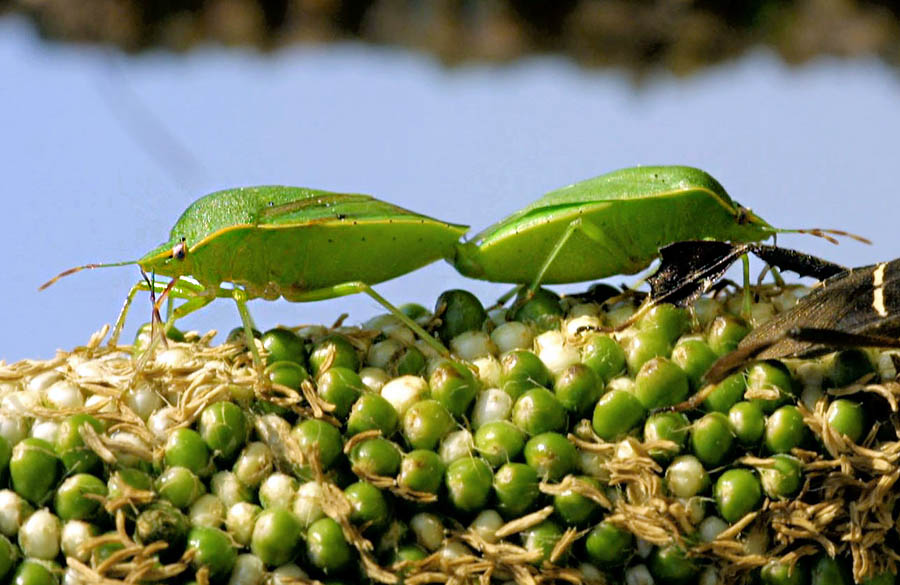In this, the era of globalisation, increases in international trade, transport and travel have driven an upsurge in the diversity and volume of non-native species introductions to new areas worldwide. Introduced plant, animal and pathogen species may fail to establish in a new range, and where they do establish, may be environmentally benign. However, there is potential for introduced non-native species to become invasive, even after a (sometimes extensive) period of time without apparent negative impacts.
Preventing the introduction and establishment of a species considered to be an invasion risk is key to mitigating its potential impacts in a new area. For this to be done effectively, it is vitally important that countries conduct horizon scanning initiatives to determine the non-native species likely to arrive, to evaluate the threat posed should the organism become established, to determine by which pathway(s) the organism may be introduced and where appropriate, to convey to the competent authority the requirement for rapid response strategies to alert list species. The recent European Union (EU) draft regulation which aims to legislate for the control of invasive non-native species in the EU is likely to be focused on a list of priority non-native species. A significant number of the species on this list are likely to be alert species not yet present in the region, but which will be determined as threats through the horizon scanning and prioritisation process. The outcomes of this horizon scanning process are likely to be of great interest and importance to various concerned parties across the European continent and beyond, and will certainly be subject to close scrutiny.
Horizon scanning protocols vary, but in essence tend to involve a team of specialists for a given taxonomic or thematic group proposing, discussing and ranking non-native species considered a risk to the region in question, often guided by databases of known invasive species and with a level of eco-climatic matching where available in order to focus on species known to be invasive in areas with similar environmental conditions. Likelihood of arrival can also be considered, with invasive species present in countries neighbouring the region in question being considered to have a high risk of introduction, for example. If a species is being considered for introduction to a region or its arrival either natural or vectored by man is thought likely then a pest risk assessment (PRA) may be undertaken. The PRA helps to establish what sort of risk the non-native species is likely to pose in its new environment. One Achilles’ heel of PRAs is that of invasive non-native ‘sleeper’ species that have not yet proven invasive elsewhere and satisfy the PRA requirements, but which go on to have long-term negative impacts.
Pathways of introduction may be human-mediated via trade and transport or natural, for example via migration or carried by water currents. Human-vectored invasions can take a variety of forms. A trans-oceanic cargo ship might transport plants, bacteria and plankton in its ballast water, with mussels, sponges and algae carried on the hull, for instance. The zebra mussel (Dreissena polymorpha) is likely to have been introduced to western Europe and North America in this manner. The brown tree snake (Boiga irregularis) which has had a devastating impact on the native bird population of Guam appears to have been introduced via the trafficking of military materials to and from the island following World War II. Solid wood packing material shipped from China is thought to have housed the Asian long-horned beetle (Anoplophora glabripennis) leading to an outbreak in the USA in 1996 which triggered emergency control measures. Thought now to have been eradicated from a number of locations in the USA, this highly damaging polyphagous beetle is an alert list species in many parts of the world, with new detections and interceptions an ongoing challenge. Invasive plants have been widely introduced to new regions in contaminated seed and through the horticultural trade. Britain, for example, has a rich history of invasive plant introductions, with the Victorians displaying a particular penchant for the exotic and weedy ornamental (see Japanese knotweed and Himalayan balsam).

The Asian long-horned beetle (Anoplophora glabripennis), internationally unwelcome
Photo: Kyle Ramirez, Wikipedia
Understanding the likelihood of establishment of a species introduced to a new region is fundamental to allowing an accurate assessment of the risk it may pose. A recent horizon scanning event conducted by the EU-funded project Reducing the Impact of Non-native Species in Europe (RINSE) analysed and ranked a registry of non-native species thought likely to pose a risk to regions of the UK, France, Belgium and the Netherlands. Environmental and socioeconomic factors were then used to produce heat maps displaying the potential distribution of alert species, indicating the regions in each country considered most suitable for the organism and where monitoring may be focused. Climate change is likely to influence the potential future distribution of many species, and these types of map can be modified to reflect environmental changes.
Ideally, the arrival of a potentially invasive species identified during the horizon scanning process would be prevented, with likely pathways of introduction established and suitable exclusionary measures put in place. If prevention of introduction fails then early detection and rapid response measures may allow for eradication of the organism, though this will be dependent on feasibility and cost-benefit analyses on a species-by-species basis. For some species, once established, impact limitation and restriction of spread may be the only viable options.
For prevention of arrival and early detection of new incursions, environmental authorities and key industries (e.g. the horticultural and pet trades) must be made aware of species of concern. Raising public awareness of key risk species can also be invaluable, particularly when used in conjunction with a system to report alert species sightings. An example of this is the GB Non-Native Species Secretariat Species Alert system, where sightings of recently introduced or likely arrivals considered high risk can be reported to allow a rapid response by the competent authority. Species currently listed on this page include the invasive aquatic plant, creeping water primrose (Ludwigia peploides often misidentified as L. grandiflora), that is found at several sites around the UK, but subject to eradication efforts and the Asian hornet (Vespa velutina) which has yet to arrive in Britain but is spreading rapidly across France and could pose a risk to apiculture through predation of bees.
Reporting systems for invasive non-native species that have been able to establish can also be useful for tracking invasions, identifying new invasion sites and targeting management efforts. Cape Town has an Early Detection and Rapid Response programme encouraging spotters to report sightings of key weed species. The Reducing Invasive Species Counts (RISC) project encourages users to record high priority invasive species in Great Britain. Various invasive species tracking apps are also available for smartphones, often combining the GPS, internet and camera capabilities of the phone to allow location-specific and confirmable sightings to be uploaded in seconds. In the UK one such example is the PlantTracker app; the RINSE That’s Invasive! app covers parts of Europe and a suite of invasive species recording apps are available in the USA.
Where do you live, and which potential invaders are of greatest concern in your region?
Corin Pratt
Invasive Species Research Scientist
@CorinPrattCABI
3 Comments
Leave a Reply
Related News & Blogs
Coronavirus and invasive species
This article was originally published on the CHAP blog. Dr Richard Shaw is Country Director and Regional Coordinator Invasives at CABI UK. Using his invasive species expertise, he examines the global spread of coronavirus In many ways a coronavirus is…
5 October 2020







Reblogged this on The Plantwise Blog and commented:
This article from the CABI Invasives Blog highlights the importance of looking to the future when determining the threat of pests to a country.
The invasive species of greatest concern to wildlands in any region is Homo sapiens.
Reblogged this on tedokonjo.